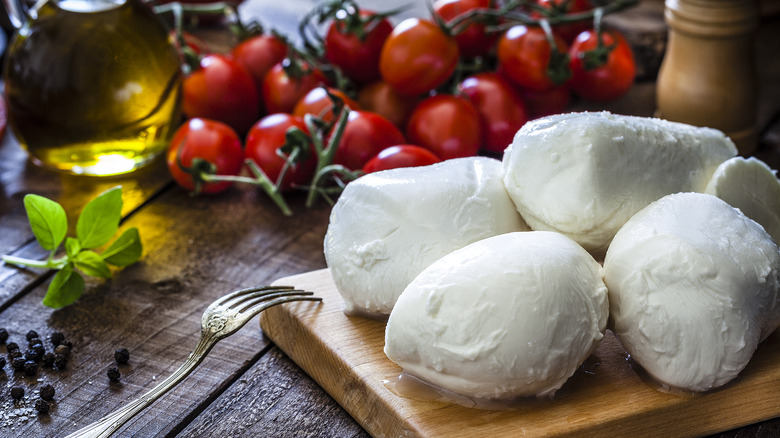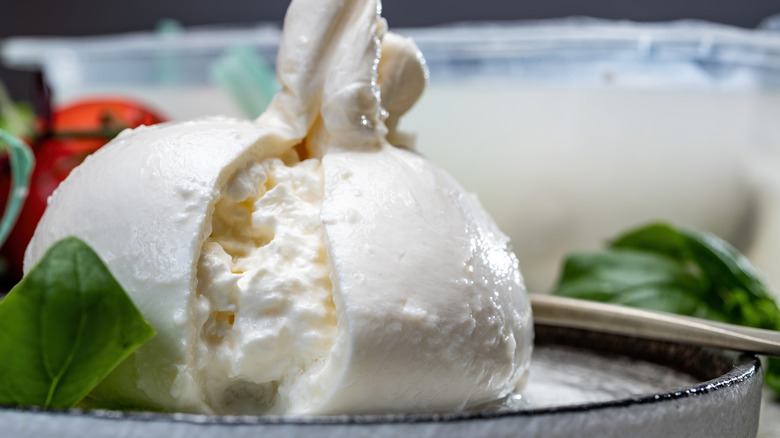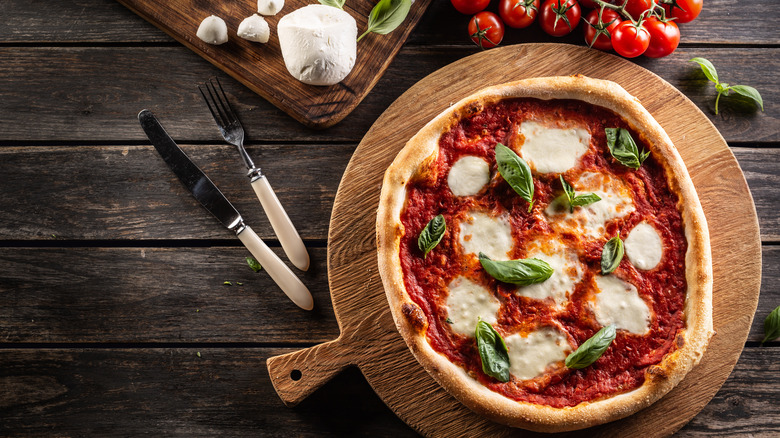The Creamy Difference Between Mozzarella And Burrata Cheese
Mozzarella is a staple ingredient in Italian cooking used to top pizzas and Caprese salads or marinated in olive oil and tossed on top of greens. But you many not be as familiar with burrata, which holds several striking similarities to mozzarella at first glance.
In fact, burrata is made with mozzarella, just with an extra creamy treatment that is perhaps the reason for its beloved notoriety. Both kinds of cheese are made from cow or buffalo milk that has been curdled with rennet (the enzyme commonly used to make cheese). The curds are then separated, cooked in hot liquid, and finally stretched (often hand-pulled) to create the classic stringy and elastic texture of mozzarella cheese.
Have you ever sliced burrata open with a knife and watched its gooey insides release, perfect for sopping it up with a hearty slice of ciabatta bread? If you know, you know. On the other hand, mozzarella is commonly formed into circular balls, braids, or knots and has a signature, firm yet semi-soft texture that makes it ideal for slicing and serving atop thick slabs of fresh tomatoes. Both mozzarella and burrata are stretched cheeses, but burrata has an extra milky inside. Made with an outer shell of cream-soaked mozzarella, burrata is formed into a pouch that holds a rich and creamy filling called stracciatella cheese.
Burrata has an extra milky filling
To make stracciatella, firm strands of mozzarella are soaked in heavy cream to hydrate them and form a silky, rich, extra milky cheese. Since mozzarella is not aged and is best eaten fresh or within five days when refrigerated and stored in water or lightly salted brine. Culture magazine reports stracciatella was developed as a byproduct of the mozzarella-making process, where it was first made to use upbraids or knots of mozzarella that had gone undesirably firm and dry over time.
When bathed in cream, the mozzarella strands take on a life of their own. The resulting cheese can be eaten as is and is especially delicious over bread or fruit. But to make burrata, fresh mozzarella is stretched and formed into a pouch (similar to a steamed bun), then filled with the stracciatella. This creates an extra creamy, rich inner world for the classic mozzarella cheese that definitely adds textural intrigue. When you slice off a piece of burrata, you'll get both the squishy, springy bite of its mozzarella shell plus the creamy, moist inside that soaks into all the ingredients around it.
How to enjoy either cheese
While burrata's creamy center is decadent, delicious, and especially eye-catching when served at a dinner party, it's important to remember that it comes from classic mozzarella. Without mozzarella, burrata couldn't exist, and particular occasions call for that familiar standby while others call for creamy burrata.
In particular, mozzarella is ideal for recipes that involve cooking or baking; think of Italian pasta bakes or deep-frying breaded chunks of the stuff to make mozzarella sticks. When enjoyed fresh, mozzarella is mildly milky, silky, slightly salty, and soft enough to melt in your mouth but firm enough to shred or slice.
Burrata, on the other hand, is best exclusively served fresh to showcase its creamy stracciatella cheese center; the fresh milky taste won't survive the heat of cooking. Place a plump ball of burrata on a cheese board, drizzled with olive oil, and garnished with fresh basil, and don't forget a good crusty bread to soak up the cream. Burrata's rich inner cheese also perfectly compliments sweet fruit like peaches and is great as a flavorful topping to an arugula salad or crostini.
Ultimately, although these cheeses are similar in some ways and forever linked together — you can't even make burrata without mozzarella — they should be enjoyed in different ways. Still, all that means is they both have a place on your table or at your next dinner party!


